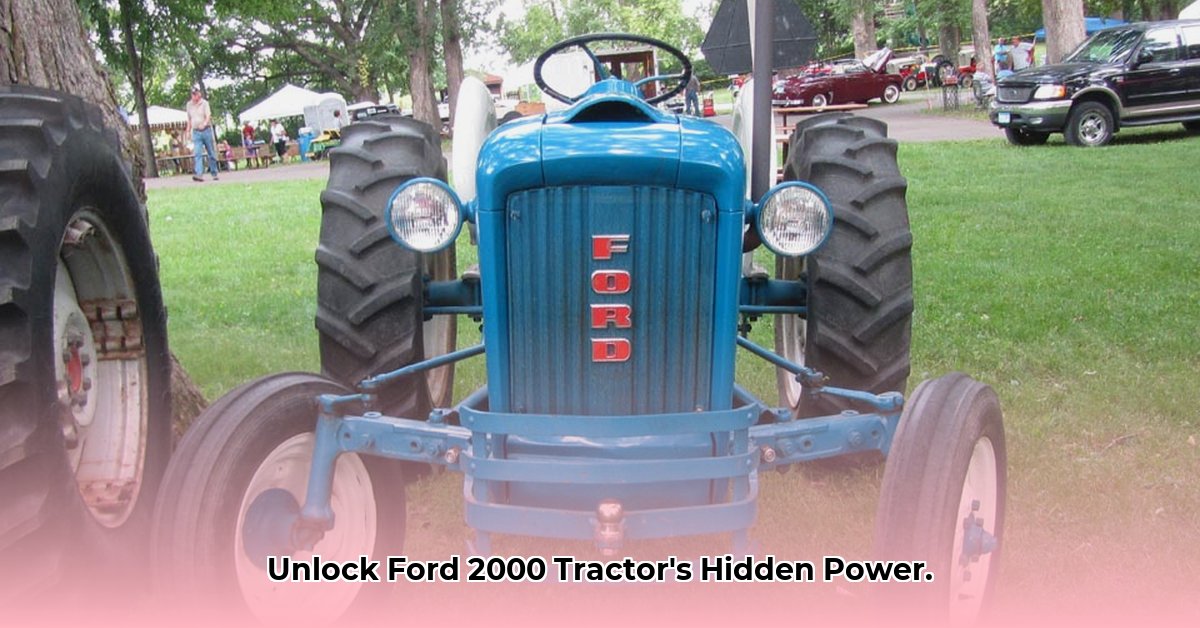
The Ford 2000 tractor, a stalwart of the agricultural landscape during the 1960s and 70s, wasn't a single model but a family of tractors, each with unique capabilities. For more in-depth details, check out this comprehensive guide: Ford 2000 details. Understanding these variations is crucial for collectors, prospective buyers, and anyone interested in the history of farm machinery. This guide delves into the specifics, helping you navigate the nuances of the Ford 2000.
Engine Power: The Heart of the Matter
The primary distinction between Ford 2000 models lies in their engines. Some featured a robust four-cylinder engine, delivering approximately 48.4 horsepower (hp), while others utilized a three-cylinder engine producing around 39 hp. This difference in gross horsepower significantly impacted performance. However, the actual power delivered to implements (PTO or drawbar horsepower) likely varied more subtly due to transmission and drivetrain efficiency. Further research is needed to precisely quantify this impact.
Transmission Options: Shifting Gears
Transmission options also varied considerably. Four-cylinder models often offered a wider array of choices—4, 5, 10, and even 12-speed transmissions, sometimes incorporating power shifts for smoother operation. Three-cylinder models generally featured simpler, unsynchronized gearboxes with fewer speed options (4, 6, 8, or 12 speeds). This variation influenced both ease of operation and versatility. A power shift, for instance, greatly enhanced speed and efficiency, especially under load.
Hydraulic Systems: Powering Implements
Hydraulic systems also differed. Interestingly, three-cylinder tractors often boasted larger hydraulic reservoirs (approximately 6.3 gallons compared to approximately 2 gallons in some four-cylinder models) and higher pressure (approximately 2500 psi versus approximately 2000 psi). This suggests a potential advantage in operating hydraulic implements for extended periods without overheating and the ability to lift heavier loads.
Model Comparison: A Summary Table
The following table summarizes the key differences between the Ford 2000 variants:
| Feature | 4-Cylinder Models | 3-Cylinder Models |
|---|---|---|
| Gross Horsepower | Approximately 48.4 hp | Approximately 39 hp |
| Transmission | 4, 5, 10, 12-speed (some with power shift) | 4, 6, 8, 12-speed (unsynchronized) |
| Hydraulic Capacity | Approximately 2 gallons | Approximately 6.3 gallons |
| Hydraulic Pressure | Approximately 2000 psi | Approximately 2500 psi |
Beyond the Specs: History and Value
The shift towards three-cylinder engines in some Ford 2000 models likely reflected broader industry trends towards lighter, more fuel-efficient tractors of that era. However, detailed analysis of the specific technological drivers behind this transition remains an area for further research. Similarly, the evolution of transmission types demonstrates advancements in design and operator experience.
The market value of a Ford 2000 tractor depends heavily on its specific model, condition, and rarity. Collectors often favor the rarer four-cylinder models due to their increased horsepower and advanced features.
Unanswered Questions and Future Research
Despite our current understanding, many questions remain about these classic tractors. Future research could focus on standardized performance testing across various models, detailed cost comparisons to understand the economic trade-offs, and comprehensive market analysis to pinpoint the actual value of each variation. For current owners, maintaining these tractors requires diligence. Joining online forums and collector clubs can prove invaluable for sourcing parts and connecting with fellow enthusiasts. Historical research into the design evolution of these tractors promises further insights into the technological progress of the period.
Comparing Ford 2000 Tractor Variants: A Practical Guide
This section provides a step-by-step approach for comparing different Ford 2000 variants effectively.
Identify Key Specifications: Begin by documenting horsepower, engine type (gasoline or diesel), transmission type, and available features for each tractor under consideration. Accurate record-keeping is paramount.
Assess Your Needs: Carefully match the tractor's capabilities to your intended applications. High-torque needs for fieldwork might favor a diesel model with a larger engine.
Evaluate Condition: A thorough inspection of each tractor's condition is essential, focusing on the mechanical and hydraulic systems. A pre-purchase inspection by a qualified mechanic is highly recommended.
Compare Pricing & Costs: Factor in the purchase price alongside potential maintenance costs. Older models, while potentially charming, may require more frequent and costly repairs.
Key Considerations: The presence of features like live PTO, flow control, and power steering significantly impacts a tractor's functionality and value. Take the time to thoroughly research these features to make an informed decision.